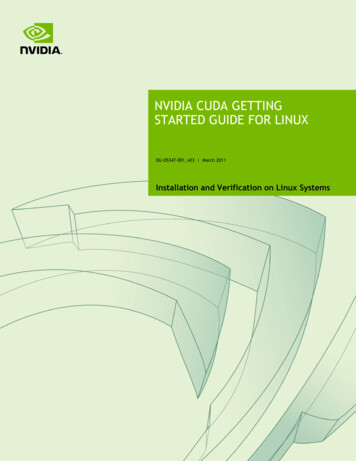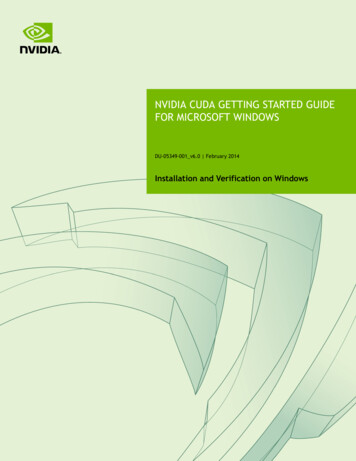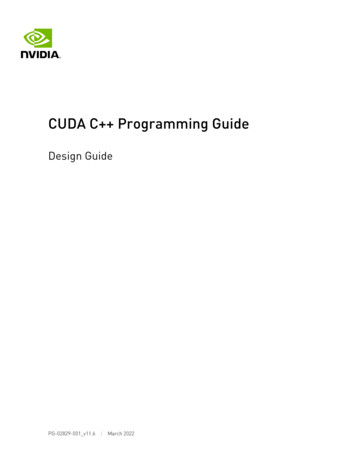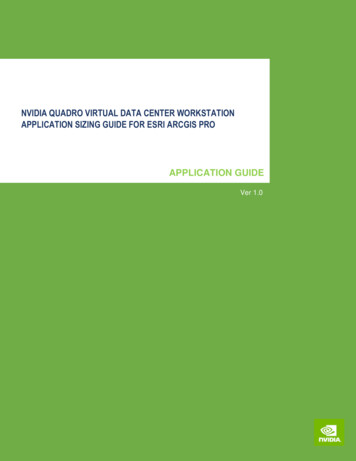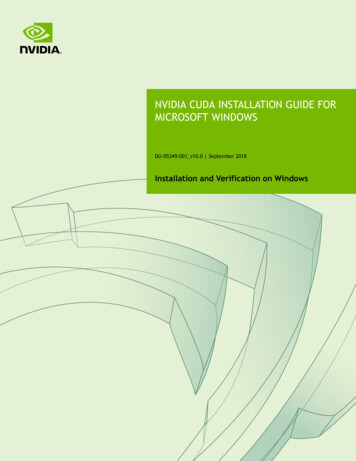
Transcription
NVIDIA CUDA INSTALLATION GUIDE FORMICROSOFT WINDOWSDU-05349-001 v10.0 September 2018Installation and Verification on Windows
TABLE OF CONTENTSChapter 1. Introduction.11.1. System Requirements. 11.1.1. x86 32-bit Support. 21.2. About This Document. 3Chapter 2. Installing CUDA Development Tools. 42.1. Verify You Have a CUDA-Capable GPU. 42.2. Download the NVIDIA CUDA Toolkit.42.3. Install the CUDA Software. 52.3.1. Uninstalling the CUDA Software. 82.4. Use a Suitable Driver Model. 82.5. Verify the Installation.92.5.1. Running the Compiled Examples.9Chapter 3. Compiling CUDA Programs.113.1. Compiling Sample Projects. 113.2. Sample Projects. 113.3. Build Customizations for New Projects. 123.4. Build Customizations for Existing Projects. 12Chapter 4. Additional Considerations. 14www.nvidia.comNVIDIA CUDA Installation Guide for Microsoft WindowsDU-05349-001 v10.0 ii
Chapter 1.INTRODUCTIONCUDA is a parallel computing platform and programming model invented by NVIDIA.It enables dramatic increases in computing performance by harnessing the power of thegraphics processing unit (GPU).CUDA was developed with several design goals in mind:‣‣Provide a small set of extensions to standard programming languages, like C, thatenable a straightforward implementation of parallel algorithms. With CUDA C/C ,programmers can focus on the task of parallelization of the algorithms rather thanspending time on their implementation.Support heterogeneous computation where applications use both the CPU andGPU. Serial portions of applications are run on the CPU, and parallel portions areoffloaded to the GPU. As such, CUDA can be incrementally applied to existingapplications. The CPU and GPU are treated as separate devices that have their ownmemory spaces. This configuration also allows simultaneous computation on theCPU and GPU without contention for memory resources.CUDA-capable GPUs have hundreds of cores that can collectively run thousands ofcomputing threads. These cores have shared resources including a register file and ashared memory. The on-chip shared memory allows parallel tasks running on thesecores to share data without sending it over the system memory bus.This guide will show you how to install and check the correct operation of the CUDAdevelopment tools.1.1. System RequirementsTo use CUDA on your system, you will need the following installed:‣‣‣‣A CUDA-capable GPUA supported version of Microsoft WindowsA supported version of Microsoft Visual Studiothe NVIDIA CUDA Toolkit (available at ia.comNVIDIA CUDA Installation Guide for Microsoft WindowsDU-05349-001 v10.0 1
IntroductionThe next two tables list the currently supported Windows operating systems andcompilers.Table 1 Windows Operating System Support in CUDA 10.0Operating SystemNative x86 64Cross (x86 32 on x86 64)Windows 10YESYESWindows 8.1YESYESWindows 7YESYESWindows Server 2016YESNOWindows Server 2012 R2YESNOTable 2 Windows Compiler Support in CUDA 10.0Native x86 64Cross (x86 32on x86 64)Visual Studio 2017 (RTW andUpdate 7)YESNOVisual Studio 2015YESNOVisual Studio Community 2015YESNOVisual C 12.0Visual Studio 2013YESYESVisual C 11.0Visual Studio 2012YESYESCompilerIDEVisual C 15.0and 15.7Visual C 14.0x86 32 support is limited. See the x86 32-bit Support section for details.1.1.1. x86 32-bit SupportNative development using the CUDA Toolkit on x86 32 is unsupported. Deploymentand execution of CUDA applications on x86 32 is still supported, but is limited to usewith GeForce GPUs. To create 32-bit CUDA applications, use the cross-developmentcapabilities of the CUDA Toolkit on x86 64.Support for developing and running x86 32-bit applications on x86 64 Windows islimited to use with:‣‣‣‣‣‣GeForce GPUsCUDA DriverCUDA Runtime (cudart)CUDA Math Library (math.h)CUDA C Compiler (nvcc)CUDA Development Toolswww.nvidia.comNVIDIA CUDA Installation Guide for Microsoft WindowsDU-05349-001 v10.0 2
Introduction1.2. About This DocumentThis document is intended for readers familiar with Microsoft Windows operatingsystems and the Microsoft Visual Studio environment. You do not need previousexperience with CUDA or experience with parallel computation.www.nvidia.comNVIDIA CUDA Installation Guide for Microsoft WindowsDU-05349-001 v10.0 3
Chapter 2.INSTALLING CUDA DEVELOPMENT TOOLSBasic instructions can be found in the Quick Start Guide. Read on for more detailedinstructions.The setup of CUDA development tools on a system running the appropriate version ofWindows consists of a few simple steps:‣‣‣‣Verify the system has a CUDA-capable GPU.Download the NVIDIA CUDA Toolkit.Install the NVIDIA CUDA Toolkit.Test that the installed software runs correctly and communicates with the hardware.2.1. Verify You Have a CUDA-Capable GPUYou can verify that you have a CUDA-capable GPU through the Display Adapterssection in the Windows Device Manager. Here you will find the vendor name andmodel of your graphics card(s). If you have an NVIDIA card that is listed in http://developer.nvidia.com/cuda-gpus, that GPU is CUDA-capable. The Release Notes for theCUDA Toolkit also contain a list of supported products.The Windows Device Manager can be opened via the following steps:1. Open a run window from the Start Menu2. Run:control /name Microsoft.DeviceManager2.2. Download the NVIDIA CUDA ToolkitThe NVIDIA CUDA Toolkit is available at http://developer.nvidia.com/cuda-downloads.Choose the platform you are using and one of the following installer formats:1. Network Installer: A minimal installer which later downloads packages required forinstallation. Only the packages selected during the selection phase of the installerwww.nvidia.comNVIDIA CUDA Installation Guide for Microsoft WindowsDU-05349-001 v10.0 4
Installing CUDA Development Toolsare downloaded. This installer is useful for users who want to minimize downloadtime.2. Full Installer: An installer which contains all the components of the CUDA Toolkitand does not require any further download. This installer is useful for systemswhich lack network access and for enterprise deployment.The CUDA Toolkit installs the CUDA driver and tools needed to create, build and runa CUDA application as well as libraries, header files, CUDA samples source code, andother resources.Download VerificationThe download can be verified by comparing the MD5 checksum posted at ms with that of the downloadedfile. If either of the checksums differ, the downloaded file is corrupt and needs to bedownloaded again.To calculate the MD5 checksum of the downloaded file, follow the instructions at http://support.microsoft.com/kb/889768.2.3. Install the CUDA SoftwareBefore installing the toolkit, you should read the Release Notes, as they provide details oninstallation and software functionality.The driver and toolkit must be installed for CUDA to function. If you have notinstalled a stand-alone driver, install the driver from the NVIDIA CUDA Toolkit.The installation may fail if Windows Update starts after the installation has begun.Wait until Windows Update is complete and then try the installation again.Graphical InstallationInstall the CUDA Software by executing the CUDA installer and following the on-screenprompts.Silent InstallationThe installer can be executed in silent mode by executing the package with the -s flag.Additional parameters can be passed which will install specific subpackages instead ofall packages. See the table below for a list of all the subpackage names.www.nvidia.comNVIDIA CUDA Installation Guide for Microsoft WindowsDU-05349-001 v10.0 5
Installing CUDA Development ToolsTable 3 Possible Subpackage NamesSubpackage NameSubpackage DescriptionToolkit Subpackages (defaults to C:\Program Files\NVIDIA GPU Computing Toolkit\CUDA\v10.0)nvcc 10.0CUDA compiler.cuobjdump 10.0Extracts information from cubin files.nvprune 10.0Prunes host object files and libraries to only contain device code forthe specified targets.cupti 10.0The CUDA Profiler Tools Interface for creating profiling and tracingtools that target CUDA applications.gpu library advisor 10.0Identifies opportunities to improve application performance byreplacing existing CPU libraries with GPU-accelerated versions ofthose libraries.memcheck 10.0Functional correctness checking suite.nvdisasm 10.0Extracts information from standalone cubin files.nvprof 10.0Tool for collecting and viewing CUDA application profiling data fromthe command-line.visual profiler 10.0GUI profiler for CUDA applications.visual studio integration 10.0Registers the CUDA plugins with supported and installed versionsof Visual Studio. Also installs Nsight Visual Studio Edition as well asthe NVIDIA Tools Extension SDK. This integration allows for CUDAdevelopment within Visual Studio.demo suite 10.0Prebuilt demo applications using CUDA.documentation 10.0CUDA HTML and PDF documentation files including the CUDA CProgramming Guide, CUDA C Best Practices Guide, CUDA librarydocumentation, etc.cublas 10.0CUBLAS runtime libraries.cublas dev 10.0CUBLAS development libraries and headers.cudart 10.0CUDART runtime libraries.cufft 10.0CUFFT runtime libraries.cufft dev 10.0CUFFT development libraries and headers.curand 10.0CURAND runtime libraries.curand dev 10.0CURAND development libraries and headers.www.nvidia.comNVIDIA CUDA Installation Guide for Microsoft WindowsDU-05349-001 v10.0 6
Installing CUDA Development ToolsSubpackage NameSubpackage Descriptioncusolver 10.0CUSOLVER runtime libraries.cusolver dev 10.0CUSOLVER development libraries and headers.cusparse 10.0CUSPARSE runtime libraries.cusparse dev 10.0CUSPARSE development libraries and headers.nvgraph 10.0NVIDIA Graph Analytics runtime libraries.nvgraph dev 10.0NVIDIA Graph Analytics development libraries and headers.npp 10.0NPP runtime libraries.npp dev 10.0NPP development libraries and headers.nvrtc 10.0NVRTC runtime libraries.nvrtc dev 10.0NVRTC development libraries and headers.nvml dev 10.0NVML development libraries and headers.occupancy calculator 10.0Excel spreadsheet used to test occupancy scenarios.fortran examples 10.0CUDA Fortran examples.Samples Subpackages (defaults to C:\ProgramData\NVIDIA Corporation\CUDA Samples\v10.0)samples 10.0Source code for many example CUDA applications using supportedversions of Visual Studio.Note: C:\ProgramData\ is a hidden folder. It can be made visiblewithin the Windows Explorer options at (Tools Options).Driver SubpackagesDisplay.DriverThe NVIDIA Display Driver. Required to run CUDA applications.For example, to install only the compiler and driver components: PackageName .exe -s nvcc 10.0 Display.DriverExtracting and Inspecting the Files ManuallySometimes it may be desirable to extract or inspect the installable files directly, such asin enterprise deployment, or to browse the files before installation. The full installationpackage can be extracted using a decompression tool which supports the LZMAcompression method, such as 7-zip or WinZip.www.nvidia.comNVIDIA CUDA Installation Guide for Microsoft WindowsDU-05349-001 v10.0 7
Installing CUDA Development ToolsOnce extracted, the CUDA Toolkit files will be in the CUDAToolkit folder, and similarilyfor the CUDA Samples and CUDA Visual Studio Integration. Within each directory isa .dll and .nvi file that can be ignored as they are not part of the installable files.Accessing the files in this manner does not set up any environment settings, suchas variables or Visual Studio integration. This is intended for enterprise-leveldeployment.2.3.1. Uninstalling the CUDA SoftwareAll subpackages can be uninstalled through the Windows Control Panel by using thePrograms and Features widget.2.4. Use a Suitable Driver ModelOn Windows 7 and later, the operating system provides two driver models under whichthe NVIDIA Driver may operate:‣‣The WDDM driver model is used for display devices.The Tesla Compute Cluster (TCC) mode of the NVIDIA Driver is available for nondisplay devices such as NVIDIA Tesla GPUs, and the GeForce GTX Titan GPUs; ituses the Windows WDM driver model.The TCC driver mode provides a number of advantages for CUDA applications onGPUs that support this mode. For example:‣‣‣‣TCC eliminates the timeouts that can occur when running under WDDM due to theWindows Timeout Detection and Recovery mechanism for display devices.TCC allows the use of CUDA with Windows Remote Desktop, which is not possiblefor WDDM devices.TCC allows the use of CUDA from within processes running as Windows services,which is not possible for WDDM devices.TCC reduces the latency of CUDA kernel launches.TCC is enabled by default on most recent NVIDIA Tesla GPUs. To check which drivermode is in use and/or to switch driver modes, use the nvidia-smi tool that is includedwith the NVIDIA Driver installation (see nvidia-smi -h for details).Keep in mind that when TCC mode is enabled for a particular GPU, that GPU cannotbe used as a display device.NVIDIA GeForce GPUs (excluding GeForce GTX Titan GPUs) do not support TCC mode.www.nvidia.comNVIDIA CUDA Installation Guide for Microsoft WindowsDU-05349-001 v10.0 8
Installing CUDA Development Tools2.5. Verify the InstallationBefore continuing, it is important to verify that the CUDA toolkit can find andcommunicate correctly with the CUDA-capable hardware. To do this, you need tocompile and run some of the included sample programs.2.5.1. Running the Compiled ExamplesThe version of the CUDA Toolkit can be checked by running nvcc -V in a CommandPrompt window. You can display a Command Prompt window by going to:Start All Programs Accessories Command PromptCUDA Samples include sample programs in both source and compiled form. To verify acorrect configuration of the hardware and software, it is highly recommended that yourun the deviceQuery program located atC:\ProgramData\NVIDIA Corporation\CUDA Samples\v10.0\bin\win64\ReleaseThis assumes that you used the default installation directory structure. If CUDA isinstalled and configured correctly, the output should look similar to Figure 1.Figure 1 Valid Results from deviceQuery CUDA SampleThe exact appearance and the output lines might be different on your system. Theimportant outcomes are that a device was found, that the device(s) match what isinstalled in your system, and that the test passed.If a CUDA-capable device and the CUDA Driver are installed but deviceQuery reportsthat no CUDA-capable devices are present, ensure the deivce and driver are properlyinstalled.www.nvidia.comNVIDIA CUDA Installation Guide for Microsoft WindowsDU-05349-001 v10.0 9
Installing CUDA Development ToolsRunning the bandwidthTest program, located in the same directory as deviceQueryabove, ensures that the system and the CUDA-capable device are able to communicatecorrectly. The output should resemble Figure 2.Figure 2 Valid Results from bandwidthTest CUDA SampleThe device name (second line) and the bandwidth numbers vary from system to system.The important items are the second line, which confirms a CUDA device was found, andthe second-to-last line, which confirms that all necessary tests passed.If the tests do not pass, make sure you do have a CUDA-capable NVIDIA GPU on yoursystem and make sure it is properly installed.To see a graphical representation of what CUDA can do, run the sample Particlesexecutable atC:\ProgramData\NVIDIA Corporation\CUDA A CUDA Installation Guide for Microsoft WindowsDU-05349-001 v10.0 10
Chapter 3.COMPILING CUDA PROGRAMSThe project files in the CUDA Samples have been designed to provide simple, oneclick builds of the programs that include all source code. To build the Windows projects(for release or debug mode), use the provided *.sln solution files for Microsoft VisualStudio 2010, 2012, or 2013. You can use either the solution files located in each of theexamples directories inC:\ProgramData\NVIDIA Corporation\CUDA Samples\v10.0\ category \ sample name or the global solution files Samples*.sln located inC:\ProgramData\NVIDIA Corporation\CUDA Samples\v10.0CUDA Samples are organized according to category . Each sample is organizedinto one of the following folders: (0 Simple, 1 Utilities, 2 Graphics, 3 Imaging,4 Finance, 5 Simulations, 6 Advanced, 7 CUDALibraries).3.1. Compiling Sample ProjectsThe bandwidthTest project is a good sample project to build and run. It is located inthe NVIDIA Corporation\CUDA Samples\v10.0\1 Utilities\bandwidthTestdirectory.If you elected to use the default installation location, the output is placed in CUDASamples\v10.0\bin\win64\Release. Build the program using the appropriatesolution file and run the executable. If all works correctly, the output should be similar toFigure 2.3.2. Sample ProjectsThe sample projects come in two configurations: debug and release (where releasecontains no debugging information) and different Visual Studio projects.A few of the example projects require some additional setup. The simpleD3D9 examplerequires the system to have a Direct3D SDK (June 2010 or later) installed and the VisualC directory paths (located in Tools Options.) properly configured. Consult theDirect3D documentation for additional details.www.nvidia.comNVIDIA CUDA Installation Guide for Microsoft WindowsDU-05349-001 v10.0 11
Compiling CUDA ProgramsThese sample projects also make use of the CUDA PATH environment variable to locatewhere the CUDA Toolkit and the associated .props files are.The environment variable is set automatically using the Build Customization CUDA10.0.props file, and is installed automatically as part of the CUDA Toolkit installationprocess.Table 4 CUDA Visual Studio .props locationsVisual StudioCUDA 10.0 .props file Install DirectoryVisual Studio 2010C:\Program Files nsVisual Studio 2012C:\Program Files zationsVisual Studio 2013C:\Program Files zationsVisual Studio 2015C:\Program Files zationsVisual Studio 2017 Visual Studio Install Dir \Common7\IDE\VC\VCTargets\BuildCustomizationsYou can reference this CUDA 10.0.props file when building your own CUDAapplications.3.3. Build Customizations for New ProjectsWhen creating a new CUDA application, the Visual Studio project file must beconfigured to include CUDA build customizations. To accomplish this, click File- New Project. NVIDIA- CUDA- , then select a template for your CUDA Toolkitversion. For example, selecting the "CUDA 10.0 Runtime" template will configure yourproject for use with the CUDA 10.0 Toolkit. The new project is technically a C project(.vcxproj) that is preconfigured to use NVIDIA's Build Customizations. All standardcapabilities of Visual Studio C projects will be available.To specify a custom CUDA Toolkit location, under CUDA C/C , select Common, andset the CUDA Toolkit Custom Dir field as desired. Note that the selected toolkit mustmatch the version of the Build Customizations.3.4. Build Customizations for Existing ProjectsWhen adding CUDA acceleration to existing applications, the relevant Visual Studioproject files must be updated to include CUDA build customizations. This can be doneusing one of the following two methods:1. Open the Visual Studio project, right click on the project name, and select BuildCustomizations., then select the CUDA Toolkit version you would like to target.2. Alternatively, you can configure your project always to build with the most recentlyinstalled version of the CUDA Toolkit. First add a CUDA build customization toyour project as above. Then, right click on the project name and select Properties.Under CUDA C/C , select Common, and set the CUDA Toolkit Custom Dir fieldwww.nvidia.comNVIDIA CUDA Installation Guide for Microsoft WindowsDU-05349-001 v10.0 12
Compiling CUDA Programsto (CUDA PATH) . Note that the (CUDA PATH) environment variable is set by theinstaller.While Option 2 will allow your project to automatically use any new CUDA Toolkitversion you may install in the future, selecting the toolkit version explicitly as in Option1 is often better in practice, because if there are new CUDA configuration options addedto the build customization rules accompanying the newer toolkit, you would not seethose new options using Option 2.If you use the (CUDA PATH) environment variable to target a version of the CUDAToolkit for building, and you perform an installation or uninstallation of any version ofthe CUDA Toolkit, you should validate that the (CUDA PATH) environment variablepoints to the correct installation directory of the CUDA Toolkit for your purposes. Youcan access the value of the (CUDA PATH) environment variable via the following steps:1. Open a run window from the Start Menu2. Run:control sysdm.cpl3. Select the "Advanced" tab at the top of the window4. Click "Environment Variables" at the bottom of the windowFiles which contain CUDA code must be marked as a CUDA C/C file. This can donewhen adding the file by right clicking the project you wish to add the file to, selectingAdd\New Item, selecting NVIDIA CUDA 10.0\Code\CUDA C/C File, and thenselecting the file you wish to add.Note for advanced users: If you wish to try building your project against a newer CUDAToolkit without making changes to any of your project files, go to the Visual Studiocommand prompt, change the current directory to the location of your project, andexecute a command such as the following:msbuild projectname.extension /t:Rebuild /p:CudaToolkitDir "drive:/path/to/new/toolkit/"www.nvidia.comNVIDIA CUDA Installation Guide for Microsoft WindowsDU-05349-001 v10.0 13
Chapter 4.ADDITIONAL CONSIDERATIONSNow that you have CUDA-capable hardware and the NVIDIA CUDA Toolkit installed,you can examine and enjoy the numerous included programs. To begin using CUDA toaccelerate the performance of your own applications, consult the CUDA C ProgrammingGuide, located in the CUDA Toolkit documentation directory.A number of helpful development tools are included in the CUDA Toolkit or areavailable for download from the NVIDIA Developer Zone to assist you as you developyour CUDA programs, such as NVIDIA Nsight Visual Studio Edition, NVIDIA VisualProfiler, and cuda-memcheck.For technical support on programming questions, consult and participate in thedeveloper forums at IDIA CUDA Installation Guide for Microsoft WindowsDU-05349-001 v10.0 14
NoticeALL NVIDIA DESIGN SPECIFICATIONS, REFERENCE BOARDS, FILES, DRAWINGS,DIAGNOSTICS, LISTS, AND OTHER DOCUMENTS (TOGETHER AND SEPARATELY,"MATERIALS") ARE BEING PROVIDED "AS IS." NVIDIA MAKES NO WARRANTIES,EXPRESSED, IMPLIED, STATUTORY, OR OTHERWISE WITH RESPECT TO THEMATERIALS, AND EXPRESSLY DISCLAIMS ALL IMPLIED WARRANTIES OFNONINFRINGEMENT, MERCHANTABILITY, AND FITNESS FOR A PARTICULARPURPOSE.Information furnished is believed to be accurate and reliable. However, NVIDIACorporation assumes no responsibility for the consequences of use of suchinformation or for any infringement of patents or other rights of third partiesthat may result from its use. No license is granted by implication of otherwiseunder any patent rights of NVIDIA Corporation. Specifications mentioned in thispublication are subject to change without notice. This publication supersedes andreplaces all other information previously supplied. NVIDIA Corporation productsare not authorized as critical components in life support devices or systemswithout express written approval of NVIDIA Corporation.TrademarksNVIDIA and the NVIDIA logo are trademarks or registered trademarks of NVIDIACorporation in the U.S. and other countries. Other company and product namesmay be trademarks of the respective companies with which they are associated.Copyright 2009-2018 NVIDIA Corporation. All rights reserved.www.nvidia.com
Visual C 12.0 Visual Studio 2013 YES YES Visual C 11.0 Visual Studio 2012 YES YES x86_32 support is limited. See the x86 32-bit Support section for details. . documentation_10.0 CUDA HTML and PDF documentation files including the CUDA C Programming Guide, CUDA
